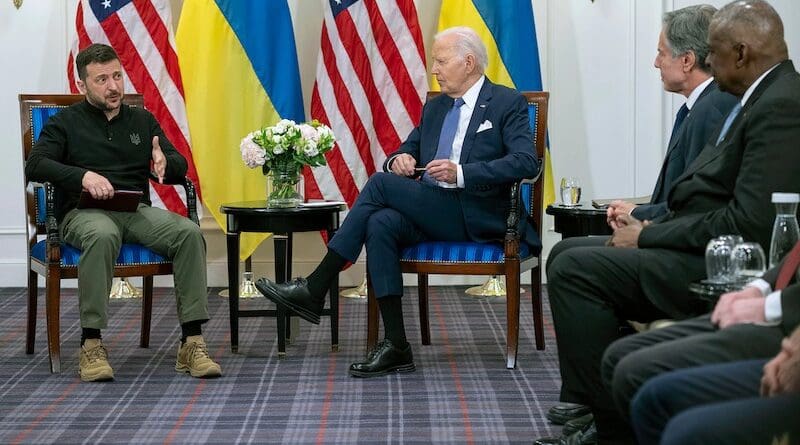Biden Looks To Persuade G7 Leaders To Endorse $50B Loan For Ukraine Using Interest From Russian Assets
By VOA
By Patsy Widakuswara
U.S. President Joe Biden is aiming to persuade leaders of the world’s seven richest economies on a plan that could potentially provide up to $50 billion in loans for Ukraine’s war effort by using interest from frozen Russian assets held in Western financial institutions.
The U.S. leader wants his G7 counterparts to endorse the plan at their upcoming summit in Apulia, Italy, set to kick off June 13. But before G7 partners can get on board, much of the scheme’s details must first be ironed out, a source familiar with Biden’s plan told VOA. If agreed upon, the loan could be disbursed as early as during the next few months.
Most of the approximately $280 billion Russian assets frozen by Western financial institutions following Moscow’s 2022 invasion are in Europe, the bulk of which are in Belgium, France and Germany.
In April, Biden signed legislation allowing Washington to seize the roughly $5 billion in Russian assets that had been immobilized in U.S. financial institutions.
Resisting pressure from the U.S. and Ukraine to seize the assets directly, EU officials in May agreed on a more restrained plan of using only the interest generated by these assets, an estimated $3 billion a year or more.
But the Biden administration is pushing for a more aggressive scheme. In simple terms, a loan of up to $50 billion will be issued up front to Ukraine by Western allies, which will be paid back using the assets’ interest income in the years to come.
If not the G7, the U.S. — possibly with other allies including Canada, the United Kingdom, Japan and the EU — would issue the loan jointly and be entitled to a share of interest generated by the assets, the source said.
Details of the plan are unclear as intensive diplomacy continues to work out the legal and technical requirements. But G7 finance ministers broadly agreed to support the principles of the plan during their meeting in May.
The group’s discussions have focused on what can be done to unlock the value of Russians’ frozen assets for the benefit of the Ukrainian people, said U.S. Treasury Deputy Secretary Wally Adeyemo.
“They talked through a number of options that will allow us to make sure that Ukraine has access to the money you need to not only invest in the economy but to invest in defense,” Adeyemo told VOA. “And my expectation is that as we get to the leaders meeting, those leaders are going to endorse some of those options.”
The push is driven in part by the situation in the battlefield, where Moscow’s forces have made strategic advances north and north-east of Kharkiv, the second biggest city in Ukraine. Russia has also intensified attacks along the eastern front.
American taxpayers’ reluctance to fund the war is another driving factor. Although the U.S. Congress in April agreed on a $61 billion aid package for Ukraine, Republican opposition had stalled its passage.
In his Friday meeting with Volodymyr Zelenskyy in Paris on the sidelines of D-Day celebrations in France, Biden apologized to the Ukrainian president for “those weeks of not knowing what was going to pan — in terms of funding,” blaming “very conservative members who were holding it up.” He pledged to continue to support Zelenskyy’s war efforts.
But as other G7 countries face the same war funding fatigue among their constituents, Biden began working with allies and partners to make Russia pay instead of burdening taxpayers, in a way that maintains unity without crossing any country’s red lines, the source said.
While there is an overall agreement to give Ukraine as much as possible, as early as possible, there are challenging legal and regulatory implications of lending based upon the anticipated returns on frozen assets, said Kristine Berzina, managing director of Geostrategy North at the German Marshall Fund think tank.
“How do you lend against the anticipated profits of the assets, how does that fit into the existing sanctions regime, and how long will those assets truly be frozen?” she pointed out to VOA as the key issues at stake. “How can you guarantee that the sanctions which freeze these assets do not get changed by the Europeans before that 50 billion is provided?”
Moscow has threatened retaliation. In May, President Vladimir Putin signed a decree that Russia will identify U.S. property, including securities, that could be used as compensation for losses sustained as a result of any seizure of frozen Russian assets in the U.S.
While some Western countries may be concerned by the threat, others are worried about the precedent of using frozen assets under international law.
Biden will seek to allay those fears when he meets with G7 leaders next week. He faces many challenges, including the European Parliament this weekend, where hundreds of millions of voters from 27 nations could help decide on the continent’s struggle between unity and nationalism, as well as determine the fate of European support for Ukraine.
VOA’s Oksana Bedratenko contributed to this report.

